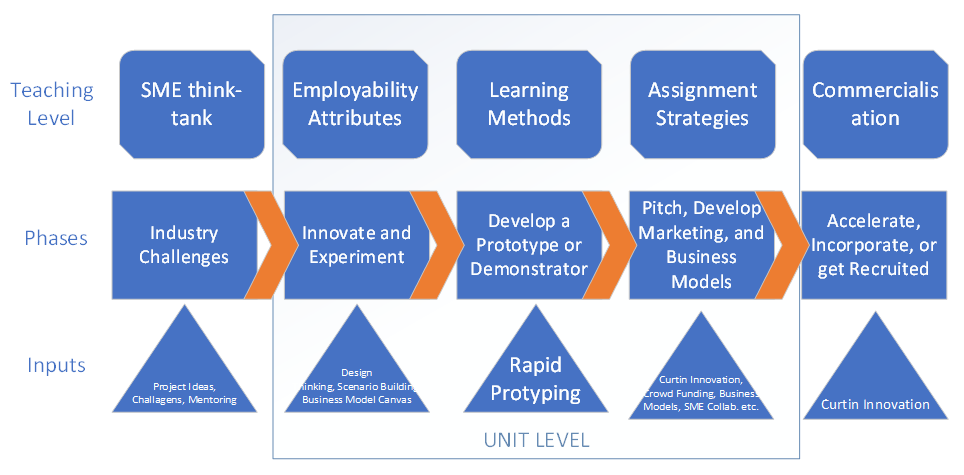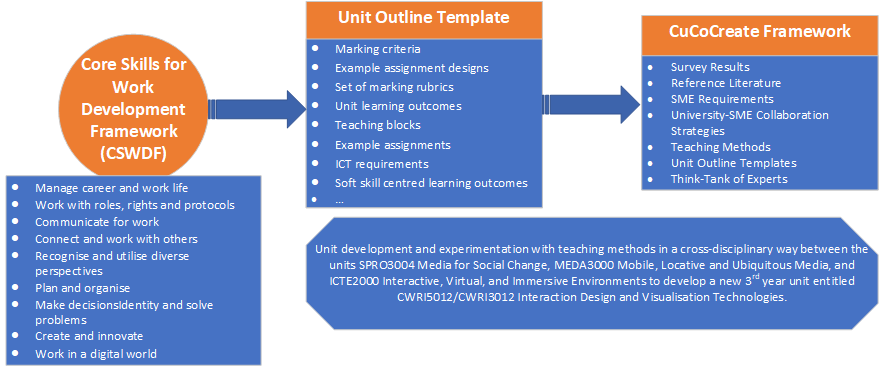Curtin Co-Create (C3) – An Innovative Teaching Framework for Making Students Ready for Working in SMEs and ‘Geek Economy’
Wednesday 3 July: 5:30pm – 7:00pm, poster session
Presenters
Artur Lugmayr
Curtin University, Australia
artur.lugmayr@curtin.edu.au
Susannah Soon
Curtin University, Australia
susannah.soon@curtin.edu.au
Wesley Lamont
Curtin University, Australia
wesley.lamont@curtin.edu.au
Gounshali Vaghjee
Curtin Mauritius, Mauritius
gvaghjee@curtinmauritius.ac.mu
Background and Context
According the Government of Western Australia, 97% of businesses are classified as small, with a share of 25% as micro (1-4 staff) and 10% small (5-19 staff), in numbers, 78.000 companies employ between 1-19 staff members. These combined contribute to 40 bn to the economy, and 20% to the gross state product [1]. In contrast to large scale corporations, SMEs require students with broader skill sets and graduate attributes than larger scale corporations. Due to mostly limited available resources, for these companies it is rather hard to collaborate with universities in teaching and research.

The diagram depicts three activity streams – teaching level, phases and inputs. The teaching level stream comprises S.M.E think tank, employability attributes, learning methods, assignment strategies and commercialisation. The Phases stream comprises industry challenges, innovate and experiment, develop a prototype or demonstrator, pitch, develop marketing and business models, and accelerate, incorporate or get ruined. The inputs stream comprises project ideas, challenges, mentoring, design thinking, scenario building, business model canvas, rapid prototyping, Curtin innovation, crowd funding, business models, S.M.E. collab. etc., and Curtin innovation.
Figure 1: Overall Project Overview and Context
To overcome this shortcoming, CuCo.Create (C3) aims to identify a model to co-create with SMEs (see Figure 1) and integrate these into a teaching environment to gain access to future employees, the creative talent of students, or which help them to become entrepreneurs. the project has three primary goals:
- the importance of making students ready for SMEs or self-employment;
- necessity of developing soft-skills and employability attributes;
- innovative approaches in cross-disciplinary work.
The goal of the project is to train students in broad skills to make them ready for SME applicability and self-entrepreneurship by 1) developing teaching methods to cover these soft/employability skills; 2) creation of a model framework for similar kinds of undertakings of Curtin university; 3) establishing a Curtin wide expert group.
Research Methods
The project relies on a mixed method approach, which include a company survey, literature review, development of framework evaluation criteria, and the creation of an expert group. These are based on the experience and results of past research works, as e.g. [2]–[4] and [5].
Research Outcomes
The main research outcomes relate to the development of a teaching framework (see Figure 2), course templates, and an overall framework to be adapted for teaching.

The diagram depicts three boxes starting with core skills work development framework, with an arrow point to unit outline template, with an arrow pointing to Cu-Co-Create framework. The first box comprises a bulleted list of manage career and work life, work with roles, rights and protocols, communicate for work, connect and work with oters, recognise and utilise diverse perspectives, plan and organise, make decisions identify and solve problems, create and innovate, and work in a digital world. The second boxes bulleted list has marking criteria, example assignment designs, set of marking rubrics, unit learning outcomes, teaching blocks, example assignments, I.C.T. requirements, and soft skill centered learning outcomes. The third boxes bulleted list has survey results, reference literature, S.M.E. requirements, university S.M.E. collaboration, strategies, teaching methods, unit outline templates, and think-tank of experts. There is an underlying box that’s not attached by arrows to the other three which contains the following. Unit development and experimentation with teaching methods in a cross-disciplinary way between the units S.P.R.O. 3004 Media for Social Change, M.E.D.A. 3000 mobile, locative and ubiquitous media, and I.C.T.E. 2000 iterative, virtual, and immersive environments to develop a new 3rd year unit entitled C.W.R.I 5012 / C.W.R.I. 3012 interation design and visualisation technologies.
Figure 2: Skills Framework as Project Outcome
References
Government of Western Australia, “Small Business in Western Australia – at a glace.” [Online]. Available: https://www.smallbusiness.wa.gov.au/about/small-business-sector/facts-and-statistics
Lugmayr, “Applying ‘Design Thinking’ as Method for Teaching in Media Education,” in Proceedings of the 15th International Academic MindTrek Confernece: Envisioning Future Media Environments, 2011, pp. 332–334.
Lugmayr, M. Jalonen, Y. Zou, L. Libin, and S. Anzenhofer, “Design Thinking” in Media Management Education – A Practical Hands-On Approach,” in 4th Semantic Ambient Media Experience (SAME) Workshop in Conjunction with the 5th International Convergence on Communities and Technologies, 2011.
Lugmayr, B. Stockleben, Y. Zou, S. Anzenhofer, and M. Jalonen, “Applying Design Thinking in the context of media management education,” Multimedia Tools and Applications, pp. 1–39, 2013 [Online]. Available: http://dx.doi.org/10.1007/s11042-013-1361-8
Lugmayr and D. Vogel, Managing and Leading Creative Universities – Foundations of Successful Science Management. Springer-Verlag.
Presentation topic
Poster session
